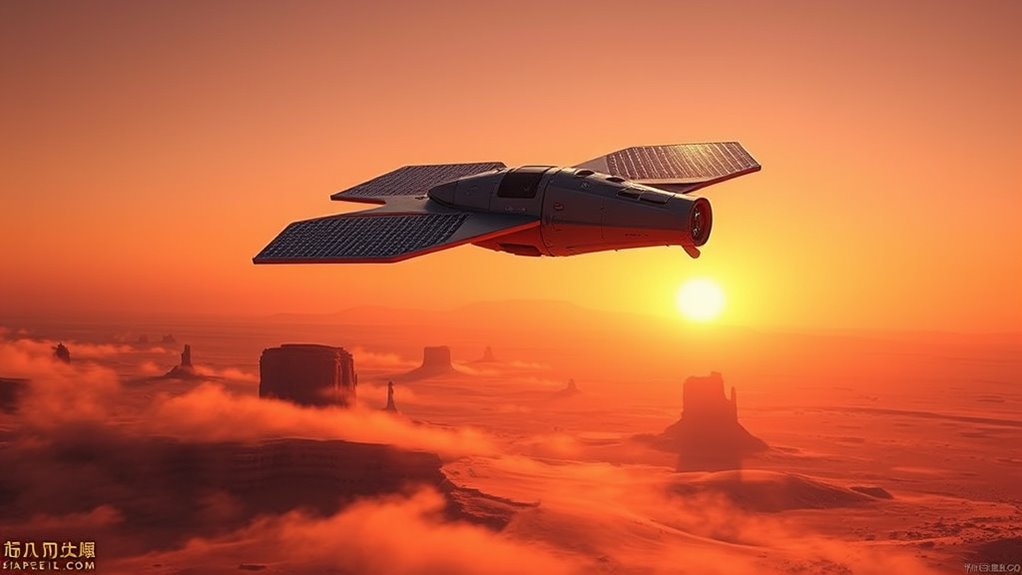China plans an ambitious Mars sample return mission by 2030, aiming to rival NASA’s longstanding exploration programs. You’ll see a complex, multi-stage operation involving a rover, fetch rover, and return capsule to collect, transfer, and bring back Martian samples. This mission will advance China’s space capabilities and deepen understanding of Mars’ geology, climate, and potential for past life. Keep exploring to discover more about this groundbreaking endeavor.
Key Takeaways
- China aims to complete its Mars sample return mission by 2030, showcasing advanced space exploration capabilities.
- The mission involves a rover, fetch rover, and return capsule to collect and bring back Martian samples.
- It focuses on analyzing Mars’ geology, climate history, and potential past life indicators.
- The spacecraft design emphasizes lightweight, durable materials with autonomous operation features.
- This mission positions China as a key player in planetary exploration, rivaling NASA’s longstanding programs.

Have you ever wondered what secrets Mars holds beneath its surface? As China gears up for its ambitious Mars sample return mission by 2030, you’re about to see how this effort could rival even NASA’s longstanding exploration programs. The mission’s goal is to retrieve rock and soil samples from Mars and bring them back to Earth for detailed analysis. To do this, China must develop cutting-edge spacecraft design and understand Mars geology more intimately than ever before. This mission isn’t just about exploration; it’s about revealing the planet’s history, climate, and potential for past life.
When you think about Mars geology, you realize it’s the key to understanding the planet’s past. The landscape features ancient riverbeds, volcanic plains, and layered sediments that tell a story billions of years old. China’s scientists and engineers need to analyze this terrain remotely and select ideal sampling sites. This requires advanced onboard instruments capable of identifying unique minerals and organic compounds. The spacecraft design must incorporate robust systems for landing, collecting samples, and launching them back into orbit. Every component is carefully engineered to withstand Mars’ harsh conditions, including dust storms and extreme temperatures. The precision needed is extraordinary—landing sites must be carefully selected to maximize sample diversity while minimizing risks.
Your focus might turn to the spacecraft design itself, which is a marvel of engineering. The mission involves several stages: a rover capable of traversing rugged terrain, a sample collection system, and a fetch rover to retrieve cached samples. These systems are integrated into a lander that can operate autonomously on Mars’ surface. The return module must then lift off from Mars, dock with an orbiter, and transfer the samples to a capsule heading back to Earth. Every step demands meticulous planning and innovation. China’s engineers are working on lightweight yet durable materials, reliable propulsion systems, and sophisticated navigation tech to guarantee success. They’re also implementing remote operation capabilities, allowing adjustments from Earth as needed.
This mission represents a leap forward in space exploration technology. It’s not just about collecting samples; it’s about demonstrating China’s capabilities to design spacecraft that can meet complex challenges in extraterrestrial environments. As you follow these developments, it becomes clear that China’s Mars program is a significant step toward becoming a major player in planetary science. The successful return of samples would give scientists worldwide invaluable insights into Mars’ geology, climate history, and its potential to have supported life. In the end, this mission could reshape our understanding of the Red Planet and our place within the solar system.
Frequently Asked Questions
What Are China’s Long-Term Space Exploration Goals Beyond Mars?
Your question about China’s long-term space exploration goals extends beyond Mars, focusing on interplanetary colonization and deep space research. China aims to establish a sustainable presence on the Moon and Mars, develop advanced propulsion systems, and explore asteroids and other celestial bodies. These efforts support their vision for humanity’s future in space, advancing scientific knowledge, resource utilization, and the potential for interplanetary settlement.
How Does China’s Mars Mission Compare to Its Lunar Programs?
Did you know China’s lunar program launched 14 missions by 2022, compared to its Mars exploration efforts? While lunar missions focus on robotic exploration and establishing a sustainable presence, China’s Mars mission aims for technological advancements like sample return by 2030. The lunar program is more established, but Mars exploration pushes China into new frontiers, showcasing a strategic dual approach to deepen their space capabilities and scientific understanding.
Will China Collaborate With Other Countries on Mars Sample Return?
You might wonder if China will collaborate internationally on its Mars sample return mission. While China emphasizes technological collaboration, it’s uncertain if they’ll fully engage in international cooperation for this ambitious project. Historically, China has focused on self-reliance, but as space exploration progresses, they could partner with other countries to share expertise and resources. This approach could enhance the mission’s success and foster global teamwork in space exploration efforts.
What Technologies Is China Developing Specifically for the Mars Mission?
You’re curious about the technologies China is developing for their Mars mission. They’re working on advanced landing systems to guarantee a safe Mars landing, including precision navigation and robust entry, descent, and landing tech. For sample collection, they’re designing specialized robotic arms and containers to gather and store samples efficiently. These innovations aim to improve the success of their Mars landing and sample collection, showcasing China’s growing space exploration capabilities.
How Will the Mars Sample Return Impact China’s Space Industry Growth?
You’ll see the Mars sample return boost China’s space industry considerably. This ambitious project will push technological innovation, leading to advanced spacecraft, robotics, and mission management skills. As you follow these developments, you’ll notice increased investments, international collaborations, and a stronger global position. The mission’s success could accelerate China’s space capabilities, opening doors for future exploration and scientific discovery, ultimately transforming the nation into a major player in space exploration.
Conclusion
As you follow China’s bold plans for the Mars sample return mission by 2030, remember the saying, “Fortune favors the bold.” Their ambitious effort shows that daring to dream big can lead to groundbreaking discoveries. While others may hesitate, China’s determination pushes the boundaries of space exploration. Keep an eye on this journey, because sometimes, the greatest rewards come to those who dare to reach for the stars.









